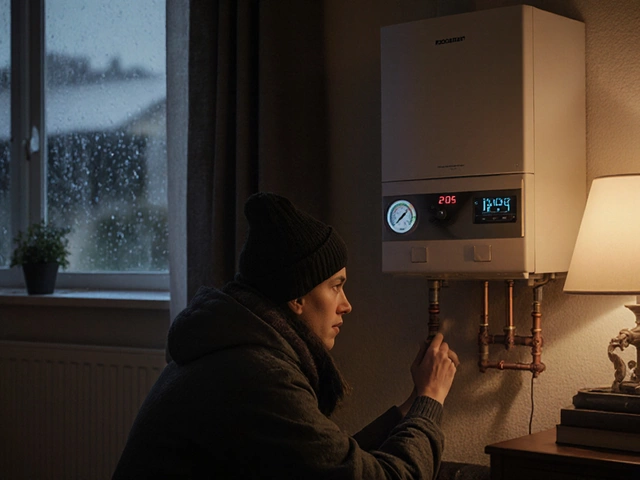You know that sinking feeling when you preheat the oven, stick in a pan of brownies, and two hours later it’s still gooey in the middle? Ovens always seem to act up when you need them most. And honestly, most oven issues boil down to a handful of classic problems.
Heating problems top the list. Maybe the oven light is on and the fan spins, but your food stays cold. Or sometimes, one side of your pizza is burned while the other’s pale as dough. That’s usually a hint the heating element is on its last legs, or the thermostat just isn’t reading properly anymore. Don’t ignore weird smells or buzzing either—that might mean wires are frying, which isn’t just annoying but dangerous.
If you’re dealing with an oven that’s slow to cook or throwing wild temps, you’re not alone. These issues can often be fixed without fancy tools or a repair bill. But knowing when to try a little DIY vs. when to call a tech can save you cash, spare your dinner plans, and keep things safe in the kitchen.
- Why Ovens Break Down (And When)
- The Dreaded Oven Won’t Heat Up Problem
- Unreliable Temperatures and Bad Baking
- Odd Noises, Smells, and Worn-Out Parts
- Simple Fixes You Can Try First
- When to Call in an Expert
Why Ovens Break Down (And When)
Ovens don’t just quit out of nowhere—they usually give you a few warning signs first. The “when” is almost always linked to how often (and how hard) you use your oven. If you’re firing it up for daily meals, especially with heavy roasting or baking, things naturally wear out faster. Most people start running into common oven problems after 5 to 10 years, but it depends on the brand and how well you keep it clean.
Let’s get specific. The most frequent culprits when your oven stops working are:
- Heating elements burn out. This is the part that actually gets hot. If it looks blistered or has bright spots, it’s probably gone bad.
- Thermostats and sensors fail. When your oven keeps overshooting or undershooting the temp, it’s usually the thermostat or sensor throwing things off.
- Electronic boards die. All those fancy digital controls? They’re cool—until they short-circuit from a power surge or just old age.
- Igniters go bad (in gas ovens). If your oven clicks but won’t light, it’s almost always a worn-out igniter.
- Door seals weaken. That rubbery gasket keeps the heat in. If it’s cracked or loose, your oven can’t keep a steady temp.
Sometimes the problem is just plain dirt. Grease buildup on fans and sensors makes your oven run hot or cold. And a lot of breakdowns can be traced back to bad habits, like slamming oven doors or using cleaners that corrode important parts.
Here’s a snapshot of when most issues pop up, based on research from appliance manufacturers and repair shops:
| Problem Area | Average Time to Failure |
|---|---|
| Heating Element | 5-8 years |
| Thermostat/Sensor | 5-10 years |
| Control Board | 7-12 years |
| Igniter (gas ovens) | 4-7 years |
| Door Seal | 6-10 years |
Don’t wait for the oven to completely quit before doing something about it. If you catch problems early—like weird smells, uneven cooking, or a flickering display—you can fix most things before you lose pizza night or your Thanksgiving turkey.
The Dreaded Oven Won’t Heat Up Problem
When the oven turns on but just sits there, stone cold, it’s probably the most frustrating thing for any home cook. This is hands-down the most common oven problems people call about. And no, you’re not cursed—ovens old and new run into this.
The main suspects usually look like this:
- Heating element failure: If you use an electric oven, the glowing coil at the bottom or top is your main heat source. These burn out or break over time. If it looks broken, blistered, or not glowing, that’s probably it.
- Broken igniter: Gas ovens rely on the igniter to light the burner. If you don’t hear the whoosh of gas catching, or you notice a faint clicking sound but no flame, the igniter might be shot.
- Thermostat issues: The thermostat tells the oven how hot to get. When it’s faulty, you could get no heat or wild temperature swings.
- Blown fuse or tripped breaker: Lots of ovens have a fuse inside. If the oven won’t heat, check your breaker box or the oven’s own fuse first. You’d be surprised how often this solves it.
Here’s a quick breakdown of how often these culprits pop up in service calls, just so you see what you’re up against:
| Cause | % of Oven No-Heat Calls |
|---|---|
| Heating Element | 47% |
| Igniter (Gas) | 21% |
| Thermostat | 15% |
| Fuse/Breaker | 10% |
| Other | 7% |
If you’re comfortable, you can check the element by unplugging the oven and looking for visible damage. For gas ovens, listen for the sound of the igniter and see if it glows at all. And always double-check the power—sometimes it really is just the breaker.
Don’t forget: if your oven’s under warranty, don’t pry it open. And if you ever smell gas, stop messing with it and call a pro right away. No dinner is worth risking a gas leak.
Unreliable Temperatures and Bad Baking
If you’ve slaved over lasagna only to pull out a half-burned, half-raw mess, you know how frustrating oven temperature problems are. Your recipes don’t stand a chance if the actual temp keeps drifting away from what you set. This is one of the most common oven problems folks run into, and it’s usually down to a failing thermostat, dodgy sensors, or broken heating elements.
Here’s a wild stat: ovens can be off by 25–50°F (that’s 14–28°C) and still pass as “okay” at the factory. That gap can mess up everything from cookies to casseroles. The temp knob might say 350°F, but your actual heat could be way off. You can spot this if your food is constantly undercooked or comes out blackened, even when you follow the directions to the letter.
Some brands are notorious for hot spots. A study by Consumer Reports found that about 40% of electric ovens they tested had temperature swings big enough to ruin baking.
Finding out if your oven is lying to you is easy enough. Buy a cheap oven thermometer and check the difference as it heats up. Don’t trust just one reading; give it a few minutes and compare multiple spots inside the oven if you can. If things look way off, you can try recalibrating. Most newer ovens have a setting for this right in the user menu—check your manual.
For the DIY crew, here are a few things to try:
- Test using an oven thermometer every few months, especially if your oven is older than five years.
- If recalibrating doesn’t work, the temperature sensor (looks like a metal rod inside the oven) might be dirty or busted. Cleaning it with a damp cloth can sometimes help, but if it’s faulty, replacement is your best bet.
- Watch for uneven baking—one side browning fast while the other is pale means the heating element is probably failing or dirty.
- If everything takes twice as long to cook, the thermostat or control board may need swapping.
Here’s a quick reminder on what temperature differences really mean:
| Oven Set Temp | Actual Temp | Baking Result |
|---|---|---|
| 350°F (177°C) | 375°F (191°C) | Food burns on outside, raw inside |
| 350°F (177°C) | 325°F (163°C) | Food is pale, takes forever to cook |
| 350°F (177°C) | 350°F (177°C) | Perfect result (the dream!) |
Don’t be shy about calling an expert if you can’t crack the case. If your oven is still under warranty, you might score a free fix. But if you’re seeing more burnt dinners than golden bakes, getting that thermostat or control board swapped is totally worth it.

Odd Noises, Smells, and Worn-Out Parts
If your oven’s making weird noises, giving off funky smells, or you spot parts that look cooked themselves, it’s waving a red flag. These aren’t just annoyances—they point to real issues that can get worse (or even dangerous) if you shrug them off.
Banging, popping, or grinding sounds usually show something is wrong with either the fan, the motor, or a loose screw. A home oven’s convection fan should whirr quietly. If it sounds like it’s coughing up screws, turn the oven off and check for debris or a loose fan blade. Sometimes, a motor going bad makes a humming or buzzing noise. If you ignore it, the fan might stop altogether—and that means uneven baking or no airflow at all.
Smells might be even more important to notice. Burned wiring or a fishy, chemical scent (sometimes even when the oven’s off) means something electrical is cooking besides your food. This could cause a short or a fire. Musty or funky smells and excess smoke might be from food drippings burning off, but if they stick around after a cleaning, they point to deeper issues, like grease built up behind panels or even a failing heating element.
Let’s talk wear and tear. Gaskets (those flexible seals along the oven door) can get flat, ripped, or crusty. That means heat escapes, and your oven works overtime—wasting energy and ruining your recipes. Cracked elements (those metal bars in the base or top) can spark or stop working. Glass panels can also pop or shatter after years of expanding and contracting with heat.
- If you hear rattling, check all screws and racks first. Sometimes, it’s just a loose grate.
- Smell something burning? Unplug the oven and carefully check the wiring behind the panel (if you’re comfortable doing so). Look for black or melted wires.
- Replace worn gaskets early—this simple fix can save your oven and keep your electricity bill sane.
| Common Problem | What It Means | What You Can Do |
|---|---|---|
| Banging/Grinding Noise | Loose part or broken fan | Tighten screws, clean debris, call a repair tech if needed |
| Burning/Plastic Smell | Electrical issue or burned food | Unplug oven, inspect wiring, clean thoroughly |
| Cracked Heating Element | No or uneven heat | Turn off oven and replace the element |
| Worn Door Gasket | Heat loss, longer cooking | Replace gasket |
Data from appliance repair shops says that around 35% of oven problems start with weird noises or smells. Catching these early can save your oven—and maybe your next meal—from disaster.
Simple Fixes You Can Try First
Before you drop a ton of money on repairs, check a few things you can do right at home. Most oven problems start with basic issues that are easy to miss if you’re in a hurry or frustrated. Here’s what you should try first:
- Check the Power: Make sure your oven’s plugged in tight and the outlet isn’t dead. Flip the breaker to see if that’s tripped—over 35% of service calls are for power issues, not broken ovens.
- Inspect the Heating Element: If your oven’s electric, peek inside when it’s on. If the coil stays dull or has cracks, it’s shot. For gas ovens, listen for the click of the igniter.
- Test the Oven Door Seal: A warped or grimy door seal can mess with cooking times. Close the door on a piece of paper—if it pulls out easily, your seal’s letting heat escape. Clean it or replace it.
- Calibrate the Thermostat: Ovens drift over time. Toss in an oven thermometer and set your oven for 350°F. If the thermometer’s off by 20°F or more, check your manual to recalibrate or go through the simple steps below.
- Clean the Oven: Spilled grease can cause smoky smells or weird noises. Give the insides a quick scrub. Watch out for clogged vents, too.
Here are quick calibration steps most digital ovens follow:
- Press and hold the Bake button until "00" shows.
- Use the up/down arrows to adjust the oven temp in 5°F increments.
- Press Start to save.
For gas ovens that won’t stay lit, gently clean the igniter with an old toothbrush. Gunk can stop it from lighting up the flame.
If you like nerdy info, here’s how common the main oven problems pop up:
| Issue | Percent of Home Calls |
|---|---|
| Heating element failure | 32% |
| Thermostat off/calibration | 22% |
| Door seal problem | 15% |
| Power supply issue | 35% |
| Igniter failure (gas oven) | 25% |
If these tricks don’t fix it, or your oven smells like burning plastic, don’t mess around—call in a pro. If the issue is a broken display or anything electrical inside the panel, it’s safest to let someone who knows their stuff handle it.
When to Call in an Expert
There's only so much you can do with some baking soda, a YouTube video, and determination. Truth is, certain oven repair jobs just aren't safe or practical for a regular person. So, how do you know when it's time to put down the screwdriver and pick up the phone?
The big red flag is anything involving electrical wiring or gas lines. If your oven keeps tripping the breaker, smells like burning plastic, or you notice sparks behind the control panel, turn it off and don’t mess with it. Same deal for gas ovens that make odd hissing noises or smell like raw gas—shut off the gas, leave the house, and call a pro. The National Fire Protection Association says faulty ovens are a root cause in more than 9,000 residential fires a year. Safety isn’t worth risking for a quick fix.
Here’s a short list of problems where expert help isn’t optional—it’s necessary:
- Electrical short circuits or blown fuses inside the oven
- Gas leaks, even minor ones
- Broken digital control panels or touchscreens
- Noisy relays, buzzing, or random oven shut-offs
- Heating elements or igniters that are scorched or damaged
- Repeated error codes after a factory reset
If your oven is still under warranty, don’t void it by poking around. Calls to the manufacturer or an authorized repair service are usually free during the coverage window. For older ovens, the cost of repair versus replacement can be a factor. Data from HomeAdvisor in late 2024 showed the average national repair cost for an oven is around $220, but can jump well above $400 for control board swaps or major part replacements.
| Problem | DIY? | Call an Expert? |
|---|---|---|
| Heating element not working | Sometimes | Yes (if wiring is exposed) |
| Oven won’t heat at all | No | Yes |
| Strange odors or smoke | No | Yes |
| Digital controls fail | No | Yes |
| Door won’t lock/unlock | Sometimes | Yes (if motorized) |
If you’re ever second-guessing whether a fix is safe, there’s zero shame in getting a pro. I’ve seen even the handiest folks turn a small electrical issue into a kitchen disaster—especially when toddlers like Tristan are running around. Long story short: if you have doubts, bring in backup. It’ll save you money and headaches in the long run.




